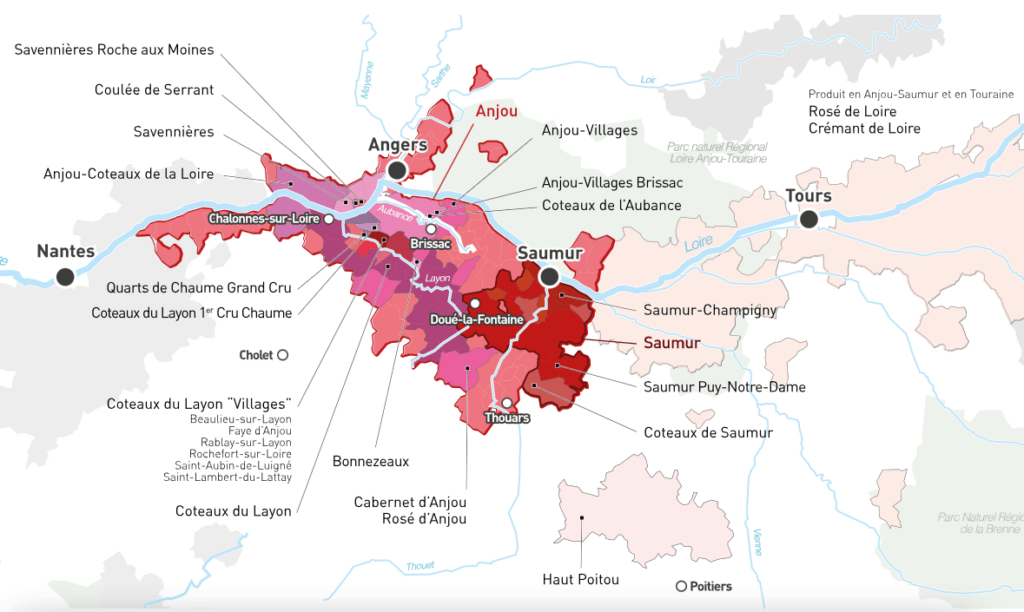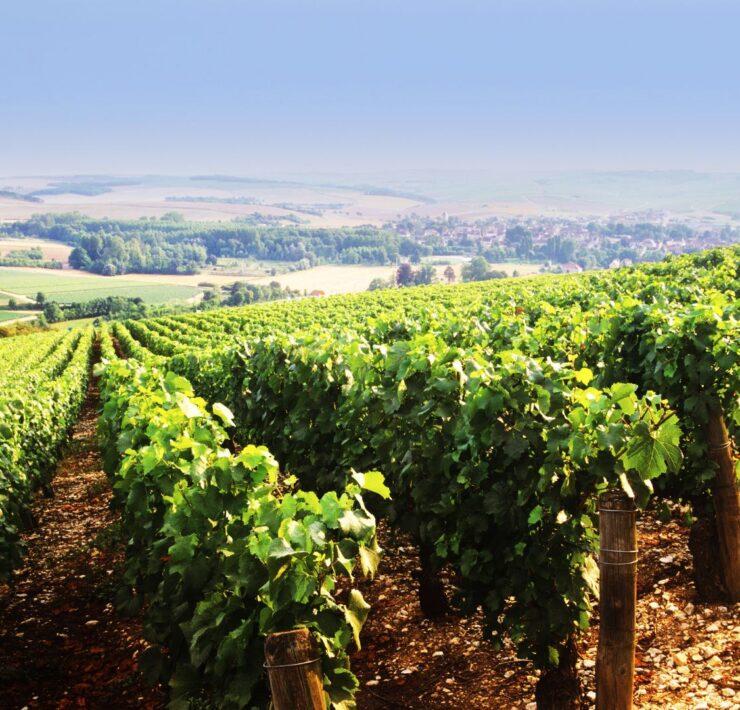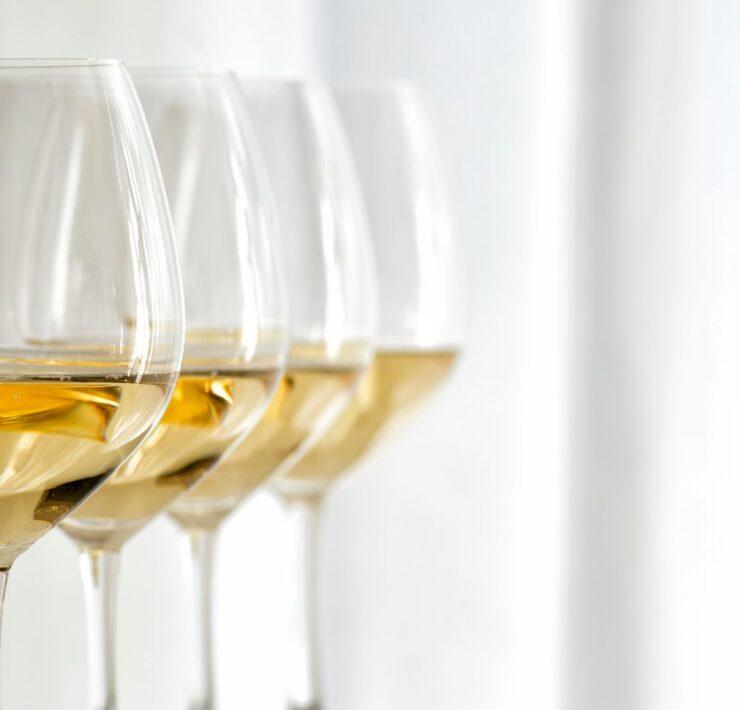The Loire is the longest river in France and a cradle of French history and culture. The latter rings especially true in the Middle Loire Valley, where lush forests and lavish Renaissance castles flank the Loire river banks. Tributaries cut through valleys and created diverse landscapes… no wonder it is often referred to as le jardin de la France – The Garden of France – a UNESCO world heritage site.
To garner a thorough understanding of the Loire Valley is not an easy feat. Therefore, the best way to discover it is in bite-sized chunks and by letting the river guide us.
After travelling north for 280miles (450km) from its source in the Massif Central, the Loire river reaches maturity at Orléans. It redirects its stream towards the west and flows through Tours, Saumur, Angers, and Nantes before emptying itself in the Atlantic ocean.

Middle Loire Valley
The Middle Loire Valley is a mosaic of magical landscapes and the kingdom of Chenin Blanc, Cabernet Franc, and Gamay. It’s made up of a wide range of soils and climats that span five sub-regions. From upstream to downstream, they include: Orléans, Loir Valley, Touraine, Saumur, and Anjou.
Orléans
Orléans is the northernmost wine-growing area of Loire. During the Renaissance, it was a highly-regarded region and often compared to Beaune and Bordeaux. Although the region has not regained its glory, quality-focused producers are now producing excellent wines reminiscent of the old days.
Appellations:
- Orléans AOC: The permitted grape varieties are Chardonnay, Pinot Noir, Pinot Meunier, and Pinot Gris – a splitting image of Champagne and Burgundy, producing still wines of all colours.
- Orléans-Cléry AOC: A tiny appellation that produces Cabernet Franc dominant reds.
Loir Valley
The Loir Valley is a quiet corner relatively separate from the rest of the Loire that large-scale commercial wine production never quite reached the region. Although this region experiences little oceanic influence from the Atlantic, the many tributaries here help regulate the temperatures of the vineyards.
Appellations:
- Coteaux du Vendômois AOC: Home to 100% Pineau d’Aunis rosé (or ‘vin gris’), Pineau d’Aunis red blends, and dry whites made from Chenin Blanc.
- Jasnières AOC: A slowly trending region, producing dry and semi-sweet still whites made from 100% Chenin Blanc.
- Coteaux du Loir AOC: 100% Chenin Blanc white wines ranging from dry to semi-sweet, as well as Pineau d’Aunis red and rosé blends.
Touraine
Touraine stretches westward towards Saumur and extends eastwards towards Blois, covering many sub-appellations in between. An area of historical and cultural significance, this stretch of Loire is where most royalties and nobilities erected most of the valley’s castles. For that reason, great quality wines ensued, including terrific examples of Chenin Blanc, Cabernet Franc, Sauvignon Blanc, Gamay and Côt.
Appellations:
- Touraine AOC and Touraine Mousseux AOC: early drinking wines that can come from Touraine, Loir Valley, and Orléans.
- Cheverny AOC: Home to Sauvignon Blanc-based sparkling and white wines and Pinot Noir-based reds and rosés.
- Cour-Cheverny AOC: A unique region home to the cult-favourite 100% Romorantin wines. This grape variety can show the characteristics of both Riesling and Chardonnay.
- Valençay AOC: Famous for the Valançay goat cheese, Valençay also produces Sauvignon-based white that pairs wonderfully with the local cheeses, as well as rosé and red blends made of Gamay, Pinot Noir, and Côt.
- Vouvray AOC: A white wine production region producing 100% Chenin Blanc in sparkling, still, and sweet expressions.
- Montlouis-sur-Loire AOC: Another trendy appellation, especially amongst the natural wine community, arguably France’s petillant-natural authority and Vouvray’s low-intervention alter ego, producing many sparkling wines and some still wines. 100% Chenin Blanc.
- Bourgueil AOC & Saint-Nicholas-de-Bourgueil AOC: Famous for red wines made from Cabernet Franc, but also produces some rosés. Quality varies. The best red wines grow on chalk (tuffeau), yielding intense wines with a wide range of flavors, and can be incredibly cellar-worthy.
- Chinon AOC: A region with incredibly diverse soil types. Chinon produces quality Cabernet Franc-dominant reds, some rosés, and dry white wines made of 100% Chenin Blanc.
- Haut-Poitou AOC: A Sauvignon-dominant region producing aromatic white wines. In addition, it makes some Cabernet Franc-based reds and a tiny bit of rosé.

Saumur
A vast majority of Saumur vineyards sit on calcium-rich Turonian chalk, growing grapes that are especially suitable for sparkling wine production. In addition to being the largest sparkling wine-producing region in the Loire, Saumur also makes tender whites, plush rosés, and bright reds made from Cabernet Franc.
Sparkling and White Wine Appellations
- Crémant de Loire AOC: Crémant de Loire are high-quality sparkling wines made using the traditional method. Although many sparkling-focused producers are based in Saumur, the grapes they source for Crémant de Loire can come from most of the Middle Valley Loire wine region. Moreover, many Champagne houses are investing in Crémant de Loire production, hinting at a promising future.
- Saumur Mousseux AOC: High-quality Chenin-dominant sparkling wines.
- Saumur Blanc AOC: 100% Chenin Blanc wines grow in chalky soils.
Rosé and Red Wine Appellations
- Saumur Rosé AOC: Usually a Cabernet Franc and Cabernet Sauvignon blend that grows on clay and sandy soils.
- Saumur Rouge AOC: Saumur’s entry-level Cabernet Franc blends that permit the use of wood chips.
- Saumur-Champigny AOC: One of the warmest wine-growing areas in the Loire Valley, producing age-worthy Cabernet Francs.
- Saumur Puy-Notre-Dame AOC: Cabernet Franc red blends from Saumur’s highest elevation area.
Sweet Wine Appellation
- Coteaux de Saumur AOC: A hard-to-find sweet wine made from 100% Chenin Blanc and is incredibly age-worthy.

Anjou
There is more to Anjou than off-dry rosés. For instance, it’s the birthplace of Chenin Blanc. Anjou is a captivating wine region that produces luring dry whites. As well as tantalizing dessert wines and some dry reds.
Sparkling Appellation
- Anjou Mousseux AOC: a refreshing and early-drinking take on Loire sparkling wines with lower atmospheric pressure (3 atm) than Cremant de Loire (4 atm).
White Wine Appellations
- Anjou Blanc AOC: Back in the days, grapes that got declassified from sweet winemaking would produce dry Anjou Blanc. These are primarily Chenin Blanc based, making fruit-forward wines suitable for early consumption.
- Savennières AOC: A premium Loire region that produces white wines made exclusively of Chenin Blanc. Wines from the Savennières crus, Roche aux Moines and Coulée de Serrant, demand some of the highest prices in the Loire wine category.
Rosé Appellations
- Anjou produces many refreshing and easy-drinking rosé wines that are perfect for accompanying the regional cuisines. The Rosé d’Anjou and Cabernet d’Anjou found in export markets are often off-dry. Domestically, many dry styles are labeled “Rosé de Loire”.
Red Wine Appellation
- There are two camps of Anjou reds: first, Gamay-dominant blends that grow on the black schist soils labelled Anjou Gamay AOC. Secondly, Cabernet-based reds from east Anjou that grow on silt and clay-based soils labelled Anjou Rouge and Anjou Villages AOCs.
Sweet Wine Appellations
All sweet wines of Anjou are 100% Chenin Blanc that grows on schist and slate soils atop the Amorican Massif. The finest examples are amongst some of the most age-worthy wines globally.
- Coteaux du Layon AOC: Most examples were affected by noble rot. Coteaux du Layon Premier Cru Chaume sits within this appellation, with stricter production requirements, produces more intense, robust wines, and demand a more premium price.
- Quarts de Chaume Grand Cru AOC: The sweet wines from Quarts de Chaume Grand Cru are sweeter and richer than that of Coteaux du Layon. These are some of the sweetest unfortified wines in France.
- Bonnezeaux AOC: Bonnezeaux produces the lightest expression of sweet wines than the appellations above.
- Coteaux de l’Aubance and Anjou-Coteaux de la Loire AOCs: These two appellations receive strong cooling influences from the Loire River, and produce sweet wines with the lowest residual sugar in the Anjou area.










